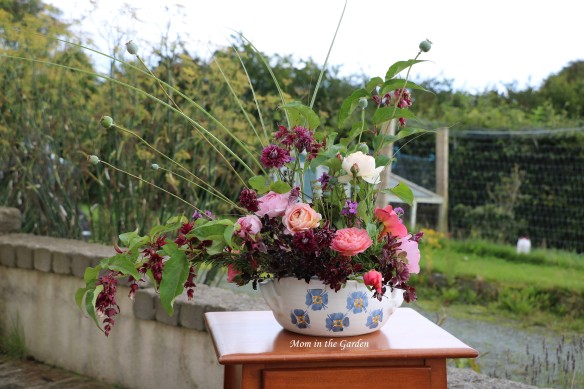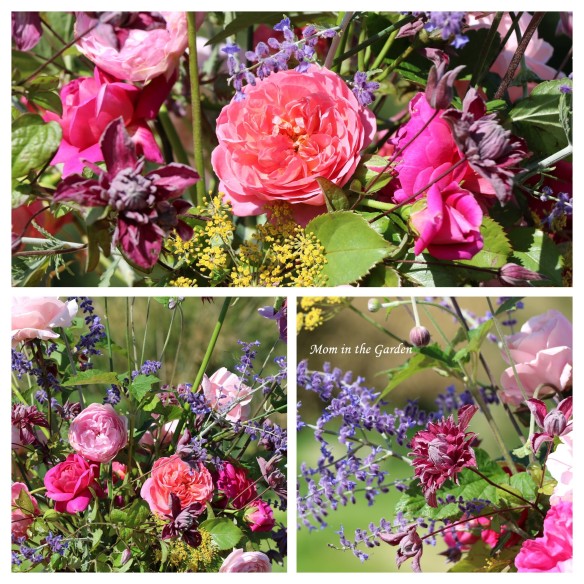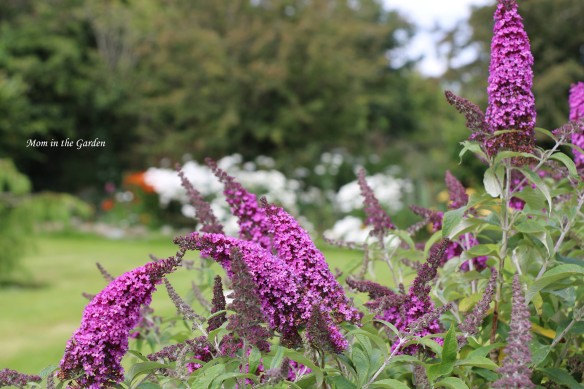Hello there! You are very welcome to my blog. Today I was working with my 16 year old daughter, making face masks together. It was her first real sewing project, and she was deservedly proud of herself. I was glad we did it together, and even more glad that she had initiated it. But confession time: sewing is something I am not comfortable with. I just never fell in love with it. I’m hoping that she will learn how to sew and learn to really enjoy it, too. Now – working with flowers – THAT is something I love to do!
I had a bunch of chores to do around the house yesterday. As a ‘treat’ to myself for doing all of that, I decided to make another flower arrangement. 🙂 All work and no play makes for a very dull day. Just like I did for my last arrangement a few weeks ago, I walked around the garden with my secateurs and snipped whatever I fancied. The tricky part was finding something ‘lofty and light’, which honestly I couldn’t find. But let me walk you through what I did use, and why:
Leycesteria formosa – also known as Himalayan honeysuckle or pheasant berry. This is great for creating structure. I love how the berries hang – giving a curve to the ends of the branch. The deep burgundy color of the berries and flowers is very pretty, too.
Pittosporum Tom Thumb – this deep, dark (purple/burgundy?) colored shrub with curly edged leaves is so easy to work with. I used it as filler to help hold things in place and to hide the white tape (see below for why I used white tape).
Rosemary – I liked the different texture of this plant. These are straight spikes and given I couldn’t really maneuver them in my container (I’ll explain below) I only used a few sprigs.
Erysimum ‘Super Bowl’ Mauve – I added these light purple stems to break up the strong tones of burgundy in the arrangement. Each stem only had a couple of small flowers on the very end of them, so I added two stems for each place that I added them. They more or less stayed together.
Clematis Purpurea Plena Elegans – this flower worked so well last time, I couldn’t pass it up. I was able to bring some of the flowers quite high, which is what I was hoping for. They are also a burgundy color.
Poppy pods – you know me, I have HUNDREDS of poppies in my garden! I collected small pods (the pod is what is left after the flower finishes blooming, and which holds the seeds) with long stems. In the center of the arrangement I have a group of them which I cut to all the same height. The rest of the pods I fanned out high above everything else.
Ornamental grass. I have one stem of this grass fanned out just on one side of the arrangement – to flow with the poppy pods and the sideways leaning Leycesteria formosa.
David Austin Roses – Eustacia Vye (an apricot-pink color), Lichfield Angel (cream), Boscobel (salmon), Scepter’d Isle (light pink) and possibly one more light pink variety but I can’t recall which one! There were too many beautiful roses in the garden to not put them in an arrangement.
The container I used is part of our pottery collection from when we were married 24 years ago (Suzanne May Irish pottery). I still love it! I used two frogs to hold the roses, but that wasn’t nearly enough for the rest of the plant materials. So I used white tape along the rim to create a bit of a grid to support the stems. Honestly, it worked well enough! You can see the white tape around the rim of the container in some of the pictures.
I gathered some flowers, started the arrangement, and then went out and gathered some more. I was delighted to have so many different plants to use!
For me, the moral of the story is, do what you love to do! I’m so glad to have planted materials that I can use for flower arranging – and I can’t wait to add some more!
I hope you are enjoying the last little bit of summer! Stay safe and healthy.
In Peace,
Dana














I hope you enjoyed your visit to Mom in the Garden! I am very happy to say that my daughter was quite happy with her sewing project and made several very nice masks. I’m so happy for her! Take care! 🙂





































